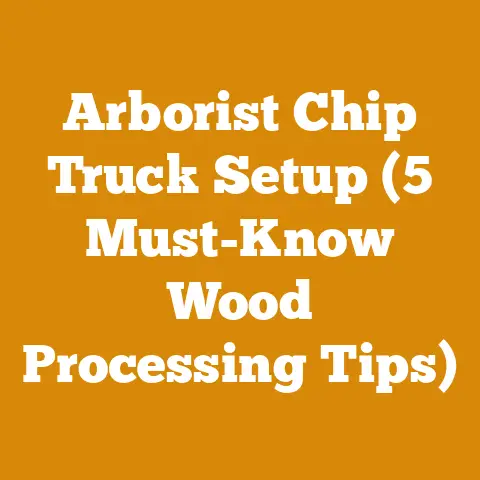Push Button Start Chainsaws: Simplify Wood Cutting (7 Pro Tips)
Imagine you’re standing in front of a classic car, gleaming under the sun. It’s beautiful, sure, but then you remember the finicky choke, the potential for vapor lock, and the sheer muscle required to crank it to life. Now, picture a modern car: sleek, efficient, and with a push-button start. That single button eliminates a whole lot of hassle. That’s exactly what a push-button start chainsaw promises – a simplified entry into the world of woodcutting. But does it deliver? And more importantly, what’s the real cost involved in embracing this modern convenience? This article dives deep into the world of push-button start chainsaws, offering pro tips, cost breakdowns, and the insights you need to make an informed decision.
Push Button Start Chainsaws: Simplify Wood Cutting (7 Pro Tips)
The allure of a push-button start chainsaw is undeniable. No more yanking on a cord until your arm feels like it’s about to fall off. No more flooded engines or frustrating starting rituals. But before you rush out and buy one, let’s delve into the reality, the costs, and the considerations that come with these modern marvels. As someone who’s spent years felling trees and splitting wood, I’ve seen firsthand how technology can change the game – for better and for worse.
Understanding the Appeal: Why Push Button Start?
The primary draw of a push-button start chainsaw is, of course, ease of use. But the benefits extend beyond that initial convenience.
- Reduced Physical Strain: Let’s face it, repeatedly pulling a starter cord is physically demanding, especially in cold weather or with a stubborn engine. A push-button start eliminates this strain, making it a great option for individuals with limited upper body strength or those who simply want to conserve energy.
- Faster Starts: In theory, a push-button start should get you cutting faster. No more fiddling with the choke or multiple pulls to get the engine going. Just push the button and go.
- Modern Technology Integration: Push-button start often comes hand-in-hand with other modern features like electronic ignition and fuel injection, which can improve overall engine performance and fuel efficiency.
- Enhanced Safety: While it might seem counterintuitive, a push-button start can enhance safety. By eliminating the need to wrestle with a starting cord, you can maintain a more stable stance and better control of the saw.
7 Pro Tips for Maximizing Your Push Button Start Chainsaw Experience
Before we get into the nitty-gritty of costs, let’s cover some essential tips to ensure you get the most out of your push-button start chainsaw:
- Power Source (Electric vs. Gas): Electric chainsaws are generally less expensive upfront than gas-powered models. However, you’ll need to factor in the cost of batteries and chargers.
- Engine Size (for Gas Models): Larger engines with more power will typically command a higher price.
- Brand Reputation: Well-known brands with a reputation for quality and reliability often charge a premium.
- Features: Additional features like automatic chain oilers, anti-vibration systems, and chain brakes can increase the price.
- Retailer: Prices can vary significantly between different retailers, both online and brick-and-mortar stores.
To give you a clearer picture, let’s break down the costs into several key categories:
1. Initial Purchase Price:
This is the most obvious cost. Here’s a general price range for push-button start chainsaws, based on my research and experience:
- Electric Chainsaws (Battery-Powered): \$150 – \$500. This range includes both small, lightweight models for pruning and larger, more powerful models for felling small trees. The battery and charger are often sold separately, adding to the overall cost.
- Gas-Powered Chainsaws: \$300 – \$800+. Gas-powered push-button start chainsaws tend to be on the higher end of the price spectrum compared to their pull-start counterparts. This is due to the added complexity of the starting system.
Data Point: According to a recent report by Grand View Research, the global chainsaw market was valued at USD 3.8 billion in 2022 and is expected to grow at a CAGR of 3.5% from 2023 to 2030. This growth is partly driven by the increasing adoption of battery-powered chainsaws and the demand for more user-friendly features like push-button start.
2. Battery Costs (for Electric Models):
If you opt for an electric push-button start chainsaw, you’ll need to factor in the cost of batteries and chargers.
- Battery Price: \$50 – \$200+ per battery. The price depends on the voltage and amp-hour rating of the battery. Higher voltage and amp-hour ratings translate to more power and longer run times.
- Charger Price: \$30 – \$100+. Some chargers are basic, while others offer features like fast charging and battery diagnostics.
Personal Story: I once bought a cheap electric chainsaw with a push-button start, thinking I was getting a great deal. However, the battery life was abysmal. I ended up spending more on additional batteries than I would have on a higher-quality chainsaw in the first place. Lesson learned: don’t skimp on battery quality.
3. Fuel and Oil Costs (for Gas Models):
Gas-powered chainsaws require a fuel-oil mixture to lubricate the engine. You’ll also need bar and chain oil to keep the chain lubricated.
- Fuel: The cost of gasoline varies depending on location and market conditions. As of late 2023, the national average price of gasoline in the United States is around \$3.50 per gallon.
- Two-Cycle Oil: A quart of high-quality two-cycle oil typically costs between \$10 and \$20.
- Bar and Chain Oil: A gallon of bar and chain oil typically costs between \$15 and \$30.
Cost Calculation: Let’s say you use 2 gallons of gasoline per month for your chainsaw. At \$3.50 per gallon, that’s \$7 per month. A quart of two-cycle oil will last you several months, so let’s estimate \$3 per month for oil. A gallon of bar and chain oil might last you 2-3 months, so let’s estimate \$7 per month for bar and chain oil. That brings your total monthly fuel and oil cost to around \$17.
4. Maintenance Costs:
All chainsaws require regular maintenance to keep them running smoothly. This includes sharpening the chain, cleaning the air filter, replacing the spark plug, and lubricating moving parts.
- Chain Sharpening: You can sharpen the chain yourself with a file or take it to a professional. Professional sharpening typically costs between \$10 and \$20.
- Air Filter: Replacement air filters typically cost between \$5 and \$15.
- Spark Plug: Replacement spark plugs typically cost between \$3 and \$10.
- Other Maintenance: Budget for occasional repairs and replacement parts, such as a new chain, bar, or carburetor.
Industry Benchmark: According to Equipment World, the average annual maintenance cost for a chainsaw is around 5% of the initial purchase price. So, if you bought a chainsaw for \$500, you can expect to spend around \$25 per year on maintenance.
5. Repair Costs:
Even with regular maintenance, chainsaws can break down. Repair costs can vary widely depending on the nature of the problem.
- Minor Repairs: Minor repairs, such as replacing a fuel line or adjusting the carburetor, might cost between \$50 and \$100.
- Major Repairs: Major repairs, such as replacing the engine or transmission, can cost several hundred dollars.
Cost Optimization: To minimize repair costs, follow the manufacturer’s recommended maintenance schedule, use high-quality fuel and oil, and avoid overloading the chainsaw.
6. Safety Gear Costs:
Safety gear is essential when operating a chainsaw. This includes a helmet, eye protection, hearing protection, gloves, and chainsaw chaps.
- Helmet: A good quality chainsaw helmet with a face shield and ear protection typically costs between \$50 and \$150.
- Eye Protection: Safety glasses or goggles typically cost between \$10 and \$30.
- Hearing Protection: Earplugs or earmuffs typically cost between \$10 and \$50.
- Gloves: Chainsaw gloves typically cost between \$20 and \$50.
- Chainsaw Chaps: Chainsaw chaps are designed to protect your legs from injury in the event of a chainsaw kickback. They typically cost between \$50 and \$150.
Safety First: Never operate a chainsaw without wearing appropriate safety gear. The cost of safety gear is a small price to pay for protecting yourself from serious injury.
7. Permit Costs (If Applicable):
In some areas, you may need a permit to cut down trees on your property or on public land. Permit costs can vary depending on the location and the type of trees you’re cutting.
Due Diligence: Check with your local authorities to determine if you need a permit before cutting down any trees. Failure to obtain a permit can result in fines and other penalties.
Case Study: Budgeting for Firewood Preparation with a Push Button Start Chainsaw
Let’s consider a hypothetical case study: You’re planning to prepare 5 cords of firewood for the winter using a gas-powered push-button start chainsaw. Here’s a breakdown of the estimated costs:
- Chainsaw Purchase: \$500
- Fuel and Oil (for 5 cords): \$50
- Chain Sharpening: \$20
- Safety Gear (Helmet, Gloves, Chaps): \$200
- Total Estimated Cost: \$770
Cost Management Tips:
- Buy firewood in bulk: Purchasing logs in bulk can significantly reduce the cost per cord.
- Sharpen the chain yourself: Learning to sharpen the chain yourself can save you money on professional sharpening services.
- Maintain your chainsaw properly: Regular maintenance will prolong the life of your chainsaw and reduce the need for costly repairs.
Variable Factors Affecting Project Costs
It’s crucial to acknowledge that numerous variable factors can influence the costs associated with wood processing or firewood preparation. These include:
- Wood Species: Different wood species have different densities and hardness, which can affect cutting time and chain wear. Hardwoods like oak and maple are more difficult to cut than softwoods like pine and fir.
- Wood Quality: The quality of the wood also plays a role. Wood that is rotten, knotty, or full of debris will be more difficult to cut and may require more frequent chain sharpening.
- Location Accessibility: The accessibility of the work site can impact labor costs and transportation expenses. If you have to haul logs long distances or work in difficult terrain, your costs will be higher.
- Seasonality: The time of year can also affect costs. During the peak firewood season (fall and winter), demand is higher, and prices may be elevated.
- Labor Costs: If you hire a logging crew or firewood handlers, labor costs will be a significant expense. Labor rates vary depending on the location and the skill level of the workers.
- Equipment Rental Fees: If you need to rent equipment like a log splitter or a wood chipper, rental fees will add to your overall costs.
Calculations and Formulas for Estimating Wood Volume and Drying Time
Here are some relevant calculations and formulas that can help you estimate wood volume and drying time:
-
Board Feet: A board foot is a unit of measurement for lumber that is 1 inch thick, 12 inches wide, and 12 inches long. To calculate the number of board feet in a log, you can use the following formula:
Board Feet = (Diameter in inches - 4) * (Length in feet / 16) -
Cords: A cord is a unit of measurement for firewood that is 4 feet high, 4 feet wide, and 8 feet long. To calculate the number of cords in a pile of firewood, you can use the following formula:
Cords = (Height in feet * Width in feet * Length in feet) / 128 -
Drying Time: The drying time for firewood depends on several factors, including the wood species, the moisture content, and the climate. As a general rule, firewood should be dried for at least 6 months before burning. You can use a moisture meter to check the moisture content of the wood. The ideal moisture content for firewood is below 20%.
Formula for Estimating Drying Time: While there isn’t a precise formula, you can estimate drying time based on initial moisture content and local climate conditions. A general guideline is that hardwoods like oak take longer to dry than softwoods like pine. In a dry, sunny climate, firewood might dry in 6-9 months. In a humid climate, it could take 12-18 months.
Current Industry Benchmarks and Statistical Data
To provide further context, here are some current industry benchmarks and statistical data related to timber prices, equipment rental fees, and fuelwood market rates:
- Timber Prices: Timber prices vary widely depending on the species, quality, and location. According to the USDA Forest Service, the average stumpage price (the price paid for standing timber) for sawtimber in the United States in 2022 was \$350 per thousand board feet.
- Equipment Rental Fees: Equipment rental fees vary depending on the type of equipment and the rental duration. According to United Rentals, the daily rental rate for a log splitter is around \$100, and the daily rental rate for a wood chipper is around \$200.
- Fuelwood Market Rates: Fuelwood market rates vary depending on the location and the type of wood. According to the Energy Information Administration, the average price per cord of firewood in the United States in 2023 is around \$250.
The Verdict: Is a Push Button Start Chainsaw Worth the Investment?
Ultimately, the decision of whether or not to invest in a push-button start chainsaw depends on your individual needs and circumstances. If you value convenience and ease of use, and you’re willing to pay a premium for those features, then a push-button start chainsaw may be a good choice for you. However, if you’re on a tight budget or you don’t mind pulling a starter cord, then a traditional chainsaw may be a more cost-effective option.
Actionable Takeaways:
- Assess your needs: Determine the type of cutting you’ll be doing most often and choose a chainsaw that is appropriate for your needs.
- Compare prices: Shop around and compare prices from different retailers before making a purchase.
- Read reviews: Read online reviews to get feedback from other users about the performance and reliability of different chainsaws.
- Factor in all costs: Don’t just focus on the initial purchase price. Consider all the costs associated with owning and operating a chainsaw, including fuel, oil, maintenance, and safety gear.
- Prioritize safety: Always wear appropriate safety gear when operating a chainsaw.
Conclusion: Cutting Through the Hype
Push-button start chainsaws offer a compelling blend of convenience and modern technology. By understanding the costs involved, following the pro tips outlined in this article, and carefully considering your individual needs, you can make an informed decision and choose the right chainsaw for your wood processing or firewood preparation projects. Remember, a chainsaw is a powerful tool that demands respect and careful operation. Whether you choose a push-button start model or a traditional pull-start model, prioritize safety and proper maintenance to ensure years of reliable service. Now, get out there and make some sawdust!






